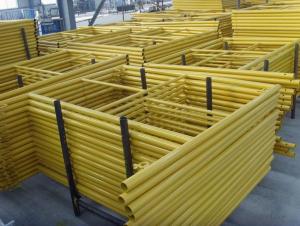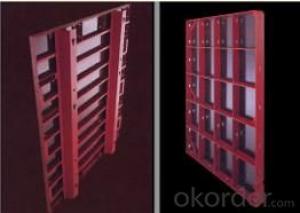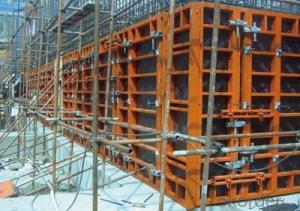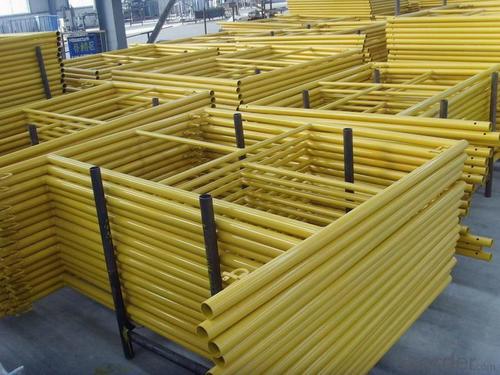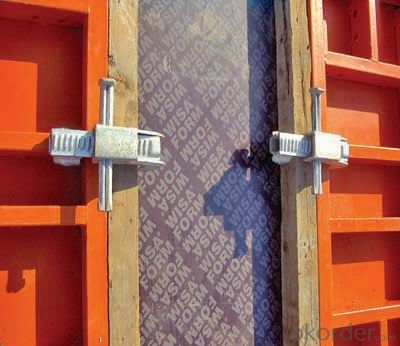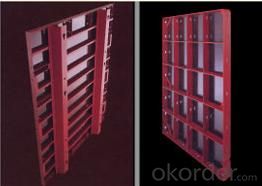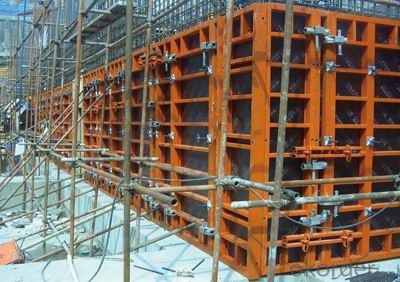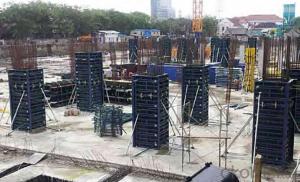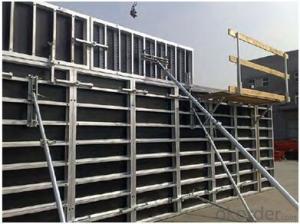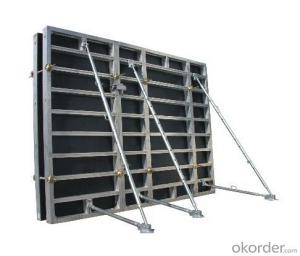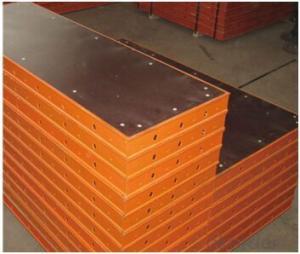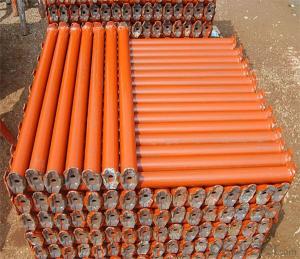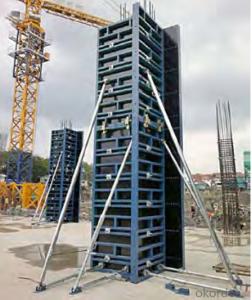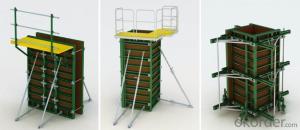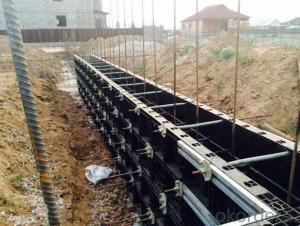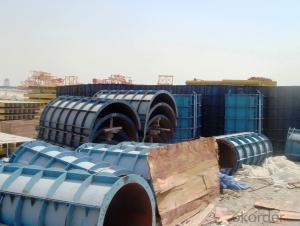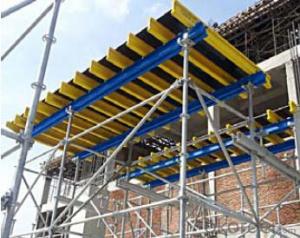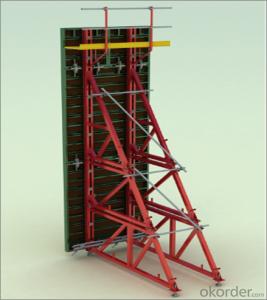Steel Frame Formwork with High Quality and Strong Strength in Construction
- Loading Port:
- Shanghai
- Payment Terms:
- TT OR LC
- Min Order Qty:
- 1 m²
- Supply Capability:
- 100000000 m²/month
OKorder Service Pledge
OKorder Financial Service
You Might Also Like
1. Structure of Steel Frame Formwork GK120
There is a prizing part designed in the corner, which can help to position and remove formwork easily.The plywood is screwed on from the back when connecting frame and plywood, so the surface of the finished concrete is perfect.The formwork series are a complete system with a full set of accessories, and can be set up flexibly according to project demand.
2. Main Features of Steel Frame Formwork GK120
High strength
High standardized system
Convenient for construction
Easy to control the quality
Easy, rapid and economical.
3. Steel Frame Formwork GK120 Images
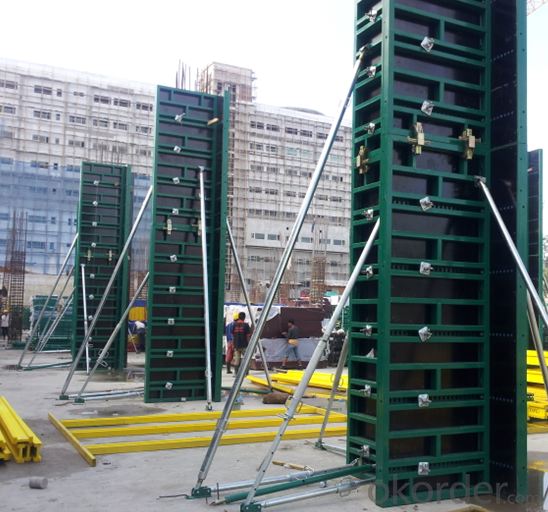
4. Steel Frame Formwork GK120 Specification
-Steel Frame Formwork GK120 is used for the concrete pouring of square or rectangle column. The system has the same structure and similar connection type with wall formwork.
-The frame is highly strengthened, and the wall formwork can bear lateral pressure 60 KN/m2 while the column formwork can bear 80 KN/m2.
-As a standardized system, it is flexible to assemble , wood batten can be filled to satisfy the need f of non-standard size.
-The adjustable steel clamp is convenient to use, and can hold tightly.
-The plywood is screwed on from the back when connecting frame and plywood, so the surface of the finished concrete is perfect.
5. FAQ of Steel Frame Formwork GK120
1) What can we do for you?
.We can ensure the quality of the vinyl banner and avoid extra expenses for customers.
.We can provide you the professional design team.
.We can provide fashionable and newest styles for you.
.We can design the artwork for you.
2) What promises can be done by us?
. If interested in Steel Frame Formwork GK120, please feel free to write us for any QUOTE.
. Please DO check goods when courier knocks your door and contact us asap if any issue.
3) What about of our after-sale service?
. Response will be carried out in 24hours after receiving any complain or request.
. Steel Frame Formwork GK120 cost can be refund after order is confirmed.
4) What about the package and shipping time?
.Packing: As Customer's Requirements
.Shipping: We have various shipping ways for our customers, such as express which including TNT, DHL, FEDEX, UPS, EMS, etc. ; by air/ sea, and we are VIP of these express.
.Shipping time:
Normally small orders, it just 10-15 business days to arrive your hand; When comes to the customs declaration, it may need 7 days.
- Q: Can steel frame formwork be used for both on-site and off-site construction projects?
- Steel frame formwork is an ideal choice for construction projects, whether they are carried out on-site or off-site. It is a versatile and durable solution that can be easily transported and assembled at any location. This makes it suitable for various construction needs. Moreover, steel frame formwork provides a stable and rigid structure that can withstand heavy loads, ensuring the accuracy and efficiency of the construction process. Another advantage is that it offers flexibility in terms of size and shape, allowing customization to meet the specific requirements of different projects. In summary, steel frame formwork is a reliable and practical option for construction projects, regardless of their location.
- Q: What are the different types of formwork braces used in steel frame formwork systems?
- Steel frame formwork systems commonly utilize various types of formwork braces to provide stability and support during the pouring and curing of concrete. These braces play a crucial role in ensuring the integrity of the formwork. Here are several different types of formwork braces commonly used: 1. Adjustable Steel Braces: Made of steel, these braces offer adjustable length and are primarily utilized for horizontal support in the formwork system. Their adjustable feature enables flexibility in adapting to different formwork heights. 2. Push-Pull Props: Also known as shore props or acrow props, these telescopic tubular supports are employed to provide vertical support in the formwork. They can be easily adjusted to the desired height and are often used in conjunction with adjustable steel braces. 3. Strut Braces: Comprising steel tubes connected diagonally to the formwork system, strut braces deliver diagonal support and hinder lateral movement of the formwork. They prove particularly valuable in situations involving high wind loads or when additional support is required. 4. Cross Braces: Steel bars are utilized as cross braces to connect vertical formwork elements. They contribute to the lateral stability of the formwork system and help maintain the desired form and shape throughout the concrete pouring process. 5. Corner Braces: Designed specifically to support the corners of the formwork system, corner braces ensure stability and squareness during the concrete pouring and curing process. 6. Tension Rods: Tension rods reinforce the overall strength of the formwork system by providing additional support and stability. They are commonly used in conjunction with other braces, such as adjustable steel braces or strut braces. These represent some of the various types of formwork braces employed in steel frame formwork systems. The selection and combination of braces depend on factors including formwork size, complexity, load requirements, and environmental conditions at the construction site.
- Q: How does steel frame formwork handle the construction of stairs and ramps?
- Steel frame formwork is an excellent option for constructing stairs and ramps due to its strength, durability, and flexibility. Comprised of steel panels, props, and connectors, the system can be easily assembled, adjusted, and dismantled according to the specific needs of stairs and ramps. During the construction of stairs, the steel frame formwork is specifically designed to bear the weight of workers and materials while concrete is poured and cured. The high-quality steel panels offer exceptional structural stability, ensuring the safety and stability of the staircase. Furthermore, the formwork system can be customized to create various types of stairs, including straight, spiral, or curved designs. Similarly, when constructing ramps, the steel frame formwork provides numerous advantages. Its adjustable props allow for the creation of ramps with different heights and slopes, making it suitable for various applications such as car parks, pedestrian walkways, or wheelchair access ramps. The system's versatility enables the construction of ramps with different configurations and dimensions. Moreover, the steel frame formwork system can be easily modified to accommodate architectural features like landings, handrails, and balustrades in the construction of stairs and ramps. This adaptability ensures that the final structure meets the desired design and functionality requirements. In summary, steel frame formwork simplifies and streamlines the construction process of stairs and ramps by offering a strong and versatile solution. Its strength, durability, and adaptability make it an exceptional choice for creating secure and dependable access points in buildings and infrastructure projects.
- Q: What are the key considerations for selecting the appropriate steel frame formwork supplier for international projects?
- When selecting the appropriate steel frame formwork supplier for international projects, there are several key considerations that should be taken into account. Firstly, it is important to assess the supplier's experience and track record in working on international projects. This includes evaluating their previous projects, particularly those that are similar in scale and scope to the project at hand. A supplier with a proven track record in successfully delivering international projects will likely have the necessary expertise and understanding of the specific requirements and challenges that may arise. Secondly, it is crucial to consider the supplier's ability to meet international standards and regulations. Different countries may have varying building codes and regulations that need to be adhered to, so it is essential that the supplier has experience in complying with these standards. This can help to ensure that the steel frame formwork supplied is of high quality and meets all necessary safety requirements. Additionally, the supplier's capacity to handle logistics and transportation for international projects should also be taken into account. This includes evaluating their ability to deliver the formwork to the project site in a timely manner, as well as their understanding of any customs and import/export requirements that may be involved. A supplier with a well-established network and efficient logistical capabilities can help to minimize delays and ensure smooth operations throughout the project. Furthermore, it is important to consider the supplier's after-sales support and technical assistance. International projects may require troubleshooting and technical guidance, so it is crucial that the supplier offers reliable support and assistance throughout the project duration. This can include providing training for onsite personnel, offering prompt responses to queries, and having a dedicated team to handle any issues that may arise. Lastly, the cost-effectiveness of the supplier's offerings should be evaluated. While it is essential to prioritize quality and reliability, it is also important to ensure that the supplier's pricing is competitive and aligns with the project's budget. This can be done through requesting detailed quotations and comparing them with other suppliers in the market. In conclusion, selecting the appropriate steel frame formwork supplier for international projects requires careful consideration of factors such as experience, compliance with international standards, logistical capabilities, after-sales support, and cost-effectiveness. By thoroughly assessing these key considerations, project stakeholders can make an informed decision and choose a supplier that is best suited to meet the project's requirements.
- Q: How does steel frame formwork impact the overall constructability of a project?
- Steel frame formwork can have a significant impact on the overall constructability of a project in several ways. Firstly, steel frame formwork provides a sturdy and reliable support structure for concrete during the construction process. This ensures that the concrete is poured and cured properly, resulting in a stronger and more durable final structure. Additionally, steel frame formwork allows for faster construction compared to traditional formwork methods. The pre-fabricated steel panels can be easily assembled and disassembled, reducing the overall construction time and increasing productivity on the site. This is particularly beneficial in projects with tight schedules or where time is of the essence. Furthermore, steel frame formwork offers flexibility and adaptability in terms of design changes. The panels can be easily adjusted to accommodate any modifications or alterations in the construction plans. This saves time and resources that would have otherwise been spent on demolishing and rebuilding formwork. Moreover, steel frame formwork contributes to a safer working environment. The steel panels are designed to withstand heavy loads and provide stability, reducing the risk of accidents and injuries on the construction site. This not only ensures the well-being of the workers but also minimizes project delays caused by safety issues. Lastly, steel frame formwork is highly durable and reusable, making it a cost-effective solution for multiple projects. The robustness of the steel panels allows them to be used repeatedly, reducing the need for constant replacement and saving construction costs in the long run. In conclusion, steel frame formwork positively impacts the overall constructability of a project by providing strength, speed, flexibility, safety, and cost-effectiveness. Its ability to support concrete and facilitate faster construction makes it an essential component in modern construction practices.
- Q: How does steel frame formwork contribute to the overall cost of a construction project?
- Steel frame formwork can contribute to the overall cost of a construction project in several ways. Firstly, it may require a higher initial investment compared to other types of formwork, such as timber or aluminum. However, this cost is often justified by its durability and reusability, as steel formwork can withstand multiple uses without significant wear and tear. Additionally, steel formwork can help to expedite the construction process by allowing for faster assembly and disassembly, reducing labor costs. Moreover, its strength and stability can minimize the need for additional support structures, saving on material costs. Overall, while steel frame formwork may have a higher upfront cost, its efficiency and longevity can result in long-term cost savings for the construction project.
- Q: Can steel frame formwork be used for both temporary and permanent construction?
- Yes, steel frame formwork can be used for both temporary and permanent construction. Steel frame formwork is a versatile and robust system that offers numerous advantages for construction projects. It provides a high level of strength, durability, and stability, making it suitable for long-term use in permanent structures. Additionally, steel frame formwork can be easily disassembled and reassembled, making it ideal for temporary structures that need to be moved or dismantled after a certain period. Its flexibility and adaptability make it a popular choice for various construction applications, whether temporary or permanent.
- Q: How does steel frame formwork address issues of concrete cracking and spalling?
- Steel frame formwork addresses issues of concrete cracking and spalling by providing a strong and stable support system for the concrete during the pouring and curing process. The steel frame ensures that the concrete is properly contained and supported, reducing the likelihood of cracking and spalling. Additionally, the steel frame formwork allows for a more uniform distribution of forces, minimizing stress concentrations that could lead to cracking.
- Q: Can steel frame formwork be used in combination with fiber-reinforced concrete?
- Yes, steel frame formwork can be used in combination with fiber-reinforced concrete. Steel frame formwork is a versatile and durable solution for creating the desired shape and structure of concrete elements. It provides stability and support during the casting process. On the other hand, fiber-reinforced concrete contains small fibers such as steel, glass, or synthetic materials that improve its properties, including tensile strength, durability, and crack resistance. When using steel frame formwork with fiber-reinforced concrete, the steel frame provides the necessary support and stability while the fiber-reinforced concrete adds additional strength and durability to the structure. The combination of these two materials allows for the construction of more robust and resilient concrete elements. Furthermore, fiber-reinforced concrete can help reduce the formation of cracks and increase the overall lifespan of the structure. This is particularly beneficial in applications where high tensile strength and resistance to cracking are required, such as in industrial floors, bridge decks, or precast elements. In conclusion, steel frame formwork can be effectively used in combination with fiber-reinforced concrete to enhance the structural integrity and durability of concrete elements. This combination allows for the construction of stronger and more resilient structures that can withstand various environmental and load conditions.
- Q: How does steel frame formwork facilitate the construction of walls and columns?
- There are several ways in which steel frame formwork aids in the construction of walls and columns. Firstly, its high durability allows it to withstand the pressure exerted by wet concrete, enabling the creation of sturdy structures capable of supporting heavy loads. Secondly, the customizable nature of steel frame formwork allows for easy adjustment to different shapes and sizes. This adaptability facilitates the construction of walls and columns with intricate designs and varying dimensions. The formwork can be quickly assembled and disassembled, leading to efficient and cost-effective construction. Furthermore, steel frame formwork ensures excellent stability and alignment, guaranteeing accurate construction according to desired specifications. This precision is crucial for maintaining structural integrity and achieving a top-quality finish. Moreover, steel frame formwork's reusability makes it an environmentally friendly option for construction projects. After each use, the formwork can be cleaned, repaired, and stored for future use, reducing waste generation and minimizing expenses. To summarize, steel frame formwork is a valuable asset in the construction of walls and columns. Its durability, flexibility, stability, and reusability all contribute to an efficient and effective construction process, resulting in strong and well-constructed structures.
Send your message to us
Steel Frame Formwork with High Quality and Strong Strength in Construction
- Loading Port:
- Shanghai
- Payment Terms:
- TT OR LC
- Min Order Qty:
- 1 m²
- Supply Capability:
- 100000000 m²/month
OKorder Service Pledge
OKorder Financial Service
Similar products
Hot products
Hot Searches
